高台寺ライトアップ(愛知県名古屋市千種区姫池通 骨董買取 古美術風光舎名古屋店)
2022.05.07
皆さま、こんにちは。辛い物が苦手なスタッフNでございます。
古美術風光舎の前にキンパのお店があるのですが、好奇心でキムチキンパを買ってしまい、辛くてヒーヒー言いながらブログを書いております。(でも美味しい)
そして、古美術風光舎名古屋店のtiktok【@fukosya】Twitter【@fu_ko_sya】アカウントを開設致しました。
ご興味のある方はフォローよろしくお願いいたします。
先日、京都へ行ってまいりました。
九州出身の連れは、「関西弁だ、すごい!おおきにって言ってる!」と田舎者丸出しではしゃいでおりました。
京都と言えば修学旅行の定番ですが、Nの学校は京都ではありませんでした。
たしか長崎か沖縄だったような気がするのですが、だいぶ昔のことゆえ、記憶が曖昧でございます。
しばらくは、京都のお寺ブログになるかもしれませんがご容赦くださいませ。
今回は、ホテルの近くの高台寺がライトアップされているとのことで行ってみました。
ライトアップと言っても、電気がついているだけかと思いきや、枯山水にプロジェクションマッピングがされていたり、中々楽しかったです。
動画はtiktokにもありますので是非ご覧ください。(初心者のため見づらくて申し訳ありません)
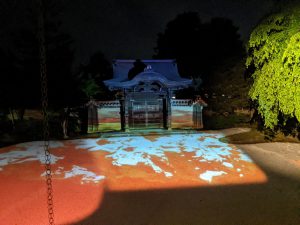
ここで、高台寺についてご一緒に勉強してまいりましょう。
高台寺、(こうだいじ)は、京都府京都市東山区にある臨済宗建仁寺派の寺院でございます。山号は鷲峰山(じゅぶさん)、寺号は詳しくは高台寿聖禅寺と称します。
豊臣秀吉の正室である北政所(高台院)が秀吉の冥福を祈るため建立した寺院であり、寺号は北政所の落飾(仏門に入る)後の院号である高台院にちなんでおります。釈迦如来を本尊とする禅宗寺院であるとともに、秀吉と北政所を祀る霊廟としての性格をもった寺院でございます。
霊屋(おたまや)の堂内装飾には桃山様式の蒔絵が用いられ、これを「高台寺蒔絵」と呼びます。他に北政所所持と伝えられる蒔絵調度類を多数蔵することから「蒔絵の寺」の通称があるそうです。
豊臣秀吉が病死したのは 慶長3年(1598年)でありました。秀吉の正室である北政所(ねね、出家後は高台院湖月心尼)は秀吉の菩提を弔うための寺院の建立を発願し、当初は北政所の実母・朝日局が眠る康徳寺(京都の寺町にあった)をそれに充てようとしたが、手狭であったため、東山の現在地に新たな寺院を建立することになりました。

秀吉没後の権力者となった徳川家康は、北政所を手厚く扱い、配下の武士たちを高台寺の普請担当に任命しました。中でも普請掛・堀直政の働きは大きかったようで、高台寺の開山堂には直政の木像が祀られているそうです。
高台寺の開山は慶長11年(1606年)で、当初は曹洞宗の寺院でありました。寛永元年7月(1624年)、高台寺は臨済宗建仁寺派の大本山である建仁寺の三江紹益を中興開山に招きました。この時、高台寺は曹洞宗から臨済宗に改宗しております。
北政所の兄・木下家定は建仁寺及び三江紹益と関係が深く、家定の七男が三江紹益のもとで出家していることも、この改宗と関連すると言われております。なお、北政所は同じ寛永元年の9月に没しております。
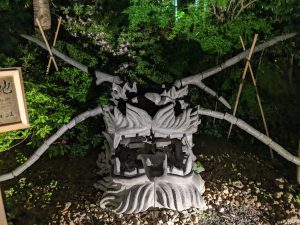
創建当時の高台寺の仏殿は前述の康徳寺の堂を移築・改造したものであり、方丈、茶室などは伏見城から移築したものでありました。また、門前に伏見城の化粧御殿が移築されて、北政所の居所とされました。高台寺の西側にある塔頭(山内寺院)の圓徳院がその跡で、北政所終焉の地とも伝わっております。
境内には高台院の甥である木下勝俊の墓塔もございます。
また高台寺は、江戸時代末期(幕末)の一時期、新選組から離脱した御陵衛士(高台寺党)の屯所となったこともございます。
その後、近世末期から近代に至る数度の火災で仏殿、方丈などを焼失。創建時の建造物で現存しているのは、三江紹益を祀る開山堂、秀吉と北政所を祀る霊屋(おたまや)、茶室の傘亭と時雨亭などでございます。
創建当時存在した仏殿は焼失後再建されておらず、方丈が中心的な建物となっております。方丈の西に庫裏、北に書院がありますが、いずれも創建当時のものではないそうです。境内東側には偃月池・臥龍池という2つの池をもつ庭園が広がり、開山堂、霊屋、茶室などがございます。また、境内からやや離れて黒門が建っております。
一番感動したのは竹林のライトアップでございます。
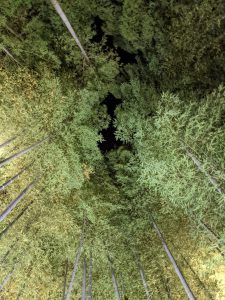
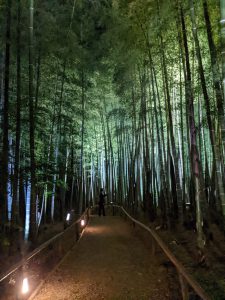
照らされた竹林に囲まれ、見下ろされる感覚、圧巻でございました。
しかし、やはり夜のお寺少し怖かったので、適度に周りに人がいて安心できるのがよさそうでございます。
高台寺の夜間特別拝観、春の部は終わってしまいましたが、次回は夏のようです。
400年前に思いを馳せて夜の京都散歩、とてもいい思い出になりました。
ではでは
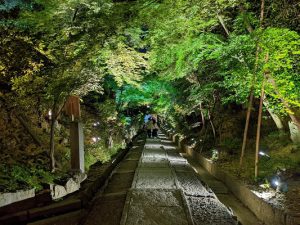
Hello everyone. Staff N is not good at spicy foods.
There is a gimbap shop in front of the antique art Fukosha, but I bought a gimbap because of my curiosity, and I am writing a blog while saying hehehe. (But delicious)
And I opened a tiktok [@fukosya] Twitter [@fu_ko_sya] account of the antique art Fukosha Nagoya store.
If you are interested, please follow us.
I went to Kyoto the other day.
A companion from Kyushu said, “Kansai dialect, it’s amazing! I’m saying big!”
Speaking of Kyoto, it is a standard school trip, but N’s school was not in Kyoto.
I think it was Nagasaki or Okinawa, but since it was a long time ago, my memory is ambiguous.
It may be a temple blog in Kyoto for a while, but please forgive me.
This time, I went to Kodaiji Temple near the hotel because it was lit up.
Even though it was lit up, I thought that it was just turned on, and projection mapping was done on the dry garden, so it was a lot of fun.
The video is also on tiktok so please take a look. (I’m sorry it’s hard to see because it’s a beginner)
Let’s study together about Kodaiji Temple here.
Kodaiji Temple is a temple of the Rinzai sect Kenninji school located in Higashiyama Ward, Kyoto City, Kyoto Prefecture. The mountain number is called Mt. Jubu, and the temple name is called Kodaiji Seizenji in detail.
It is a temple built by Toyotomi Hideyoshi’s regular room, Kodai-in, to pray for Hideyoshi’s soul. increase. It is a Zen Buddhist temple whose principal image is Shaka Nyorai, and also has the character of a mausoleum that enshrines Hideyoshi and Kodai-in.
Maki-e in the Momoyama style is used to decorate the interior of the Otamaya temple, which is called “Kodaiji lacquer work”. In addition, it is said that it is commonly known as “Maki-e Temple” because it has a large number of Maki-e furnishings that are said to be possessed by the Kita government.
Hideyoshi Toyotomi died of illness in the 3rd year of Keicho (1598). Hideyoshi’s regular room, Kitaseisho (Nene, Kodaiin Kogetsushinn after leaving the house) applied for the construction of a temple to mourn Hideyoshi’s bodhisattva. I tried to devote it to it (it was in Teramachi, Kyoto), but because it was too small, I decided to build a new temple at the current location of Higashiyama.
Ieyasu Tokugawa, who became an influential person after Hideyoshi’s death, treated the Kitaseisho with great care and appointed the samurai under his control as the general contractor of Kodaiji Temple. It seems that the work of Naomasa Hori, a general contractor, was especially great, and it seems that a wooden statue of Naomasa is enshrined in the Kaizan-do Temple of Kodaiji Temple.
Kodaiji Temple was founded in 1606, and was originally a temple of the Soto sect. In July 1624, Kodaiji Temple invited Mie Shomei of Kenninji Temple, the head temple of the Rinzai sect Kenninji Temple, to Kaisan Chuko. At this time, Kodaiji Temple was converted from the Soto sect to the Rinzai sect.
Kinoshita Iesada, the older brother of Kodai-in, has a close relationship with Kenninji Temple and Iesada Mie, and it is said that the fact that the seventh son of Iesada is a priest under Shomasu Mie is also related to this conversion. The Kita government office died in September of the same year of Kanei.
The Buddhist temple at Kodaiji Temple at the time of its construction was a relocation and remodeling of the aforementioned Kotokuji Temple, and the Hojo and tea rooms were relocated from Fushimi Castle. In addition, the makeup palace of Fushimi Castle was relocated in front of the gate and became the residence of the Kitaseisho. Entoku-in Temple at the top of the tower (Yamauchi Temple) on the west side of Kodaiji Temple is the site of the temple, and it is said to be the place where the Kita government office ended.
There is also a tomb tower of Kinoshita Katsutoshi, the nephew of Kodaiin, in the precincts.
In addition, Kodaiji Temple was once the camp of the Goryo guardian (Kodaiji Party) who left the Shinsengumi at the end of the Edo period (end of the Edo period).
After that, several fires from the end of the early modern period to the modern era burned down the Buddhist temple and Hojo. The existing buildings at the time of construction are Kaisando, which enshrines Mie Shomei, Otamaya, which enshrines Hideyoshi and Kitaseisho, and Kasatei and Shigure-tei in the tea room.
The Buddhist temple that existed at the time of its construction has not been rebuilt after it was burned down, and it is a building centered on Hojo. There is a Kuri in the west of Hojo and a Shoin in the north, but neither of them seems to be the one at the time of its construction. On the east side of the precincts, there is a garden with two ponds, Kogetsu Pond and Wolong Pond, and there are Kaisando, Sacred House, and Tea Room. In addition, the black gate is built slightly away from the precincts.
What impressed me most was the illumination of the bamboo grove.
Surrounded by the illuminated bamboo grove, it was a sight to be overlooked.
However, I was a little scared of the temple at night, so I think it would be nice to have some people around and feel at ease.
The special nighttime visit to Kodaiji Temple and the spring section are over, but it looks like summer next time.
I remembered my thoughts 400 years ago and had a very good memory of taking a walk in Kyoto at night.
See you soon
*********************
桜若葉がみずみずしい季節となりました。
風光舎では、古美術品や骨董品の他にも絵画や宝石、趣味のお品など様々なジャンルのものを買受しております。
お片付けをされていて、こういうものでもいいのかしらと迷われているものでも、どうぞお気軽にご相談下さいませ。
また風光舎は、出張買取も強化しております。
ご近所はもちろん、愛知県内、岐阜県、三重県その他の県へも出張いたします。
まずは、お電話お待ちしております。
愛知県名古屋市千種区・骨董 買取
『古美術 風光舎 名古屋店』
TEL 052(734)8444
10:00-17:00 OPEN

